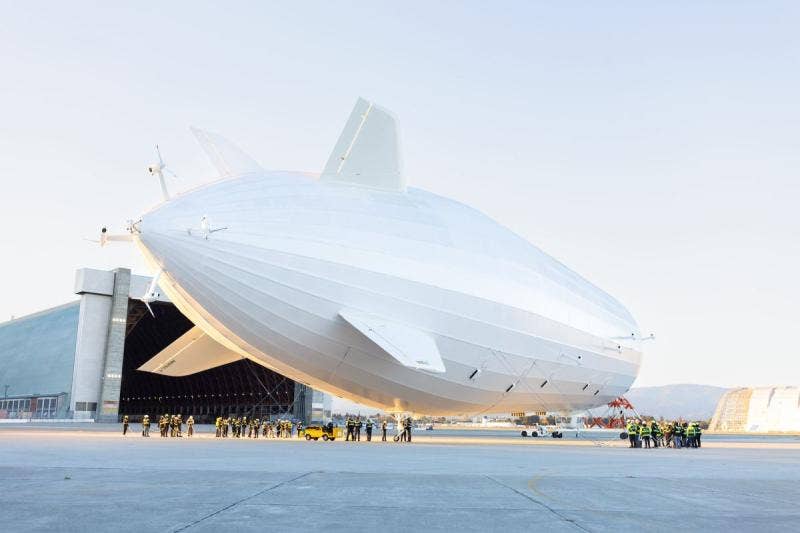LTA Pathfinder Debuts
The next-generation airship is expected to spend the next year undergoing ground and flight testing.

Pathfinder 1 is a prototype electric airship designed by LTA Research. [Courtesy: LTA Research]
Pathfinder 1, the airship from LTA Research, has made its public debut. According to TechCrunch.com, the prototype electric airship was unveiled earlyWednesday morning at Moffett Field (KNUQ) in Sunnyvale-Mountain View, California, in the heart of Silicon Valley.
According to ltaresearch.com, Pathfinder 1 is a proof of concept design. Work began on the next-generation airship shortly after LTA Research was founded in 2016. The company, backed by Google co-founder Sergey Brin, is dedicated to developing a green energy, zero-carbon transport airship capable of carrying cargo and passengers.
According to TechCrunch.com, the ship will undergo local test flights, and then be relocated to Akron, Ohio, another hotbed of LTA development, where LTA Research is allegedly planning the development of an even larger airship, Pathfinder 3.
About Pathfinder 1
According to the technology specifications on ltaresearch.com, the rigid airship measures 408 feet, 5 inches long. For comparison a Boeing 737-200 measures 102 feet in length. While the ship definitely looks like its Zeppelin predecessors, it is constructed of modern materials and features innovative engineering. For starters, the ship uses 12 electric motors developed in collaboration with Pipistrel. Control is done via a fly-by-wire system developed by LTA. The gondola, developed by Zeppelin, features a joystick and sensor feedback data supplied to the 12 motors and four fin rudders to control the ship.
Pathfinder 1 has 13 helium-filled bags made from ripstop nylon base fabric with a urethane covering.
Lidar sensors continuously and accurately calculate the volume of helium in the gas cells. This technology was developed in Akron to help pilots to balance the airship, track performance and ultimately operate more safely.
The outer skin, tested by LTA teams in Gardenerville, Nevada, noted that the Teldar material is described as lightweight, strong and nonflammable, UV resistant, and blocks visible light. The ship is painted white, which helps reflect and dissipate heat.
The interior of the airship consists of 13 circular main frames that make up the ribs. These are constructed of 3,000 welded titanium hubs and 10,000 multi-ply carbon fiber reinforced carbon tubes.
The landing gear was adapted from the gear of the Zeppelin NT and is beefier, as Pathfinder 1 is a larger ship and designed to carry heavier loads.
According to information posted on ltaresearch.com, Pathfinder 1 will spend the next year undergoing ground and flight testing, much of which will be done inside Hangar 2 at Moffett. Eventually, the testing will move outdoors. Much of the testing will mark the first time LTA inventions like its lidar monitoring system are implemented in real-world conditions.
About Moffett
Moffett Airfield has been synonymous with airships since its inception as Airbase Sunnyvale CAL in 1931, then commissioned Naval Air Station Sunnyvale in 1933. The facility was built on 1,000 acres of farmland bordering San Francisco Bay, ostensibly to provide a home for the USS Macon, one of the U.S. Navy's airships. Hangar One, measuring 1,133 feet long, 308 feet wide, and 198 feet high, is a landmark in Silicon Valley and is visible from miles away.
The property the airbase sits on is both in the cities of Mountain View and Sunnyvale, but when the proponents of the facility were lobbying Congress they were concerned the name Mountain View would cause officials to picture airships colliding with mountains, ergo they pushed the name Sunnyvale instead. Moffett has been a leader in aviation technology since 1939 with the establishment of the Ames Research Center. Today, Ames and NASA work in tandem at Moffett doing experimental flight testing, wind tunnel experiments, and space flight.

Sign-up for newsletters & special offers!
Get the latest FLYING stories & special offers delivered directly to your inbox






